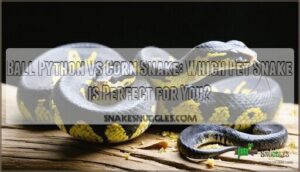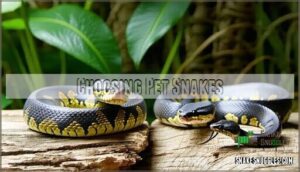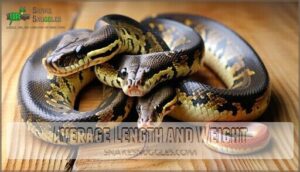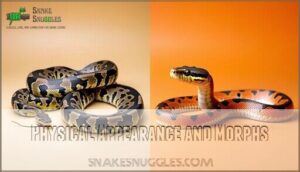This site is supported by our readers. We may earn a commission, at no cost to you, if you purchase through links.

Ball pythons are stockier, with calm temperaments and stunning morphs, but they can be picky eaters and need stable humidity.
Corn snakes are slender, lively, and easier with food, making them perfect for beginners.
Both need secure enclosures but differ in size—corn snakes rarely exceed 5 feet, while ball pythons max out around 4–5 feet but are bulkier.
Each has unique quirks, so think about handling, feeding, and care before picking.
Ready to learn the finer details of their care? Let’s explore!
Table Of Contents
- Key Takeaways
- Choosing Pet Snakes
- Snake Species Overview
- Ball Python Characteristics
- Corn Snake Characteristics
- Snake Care Requirements
- Snake Health Considerations
- Selecting Right Snake
- Frequently Asked Questions (FAQs)
- Are ball pythons friendlier than corn snakes?
- Are ball pythons the friendliest snake?
- What is bigger, ball python or corn snake?
- Are ball pythons similar to corn snakes?
- How big is a corn snake compared to a Python?
- Are ball pythons venomous?
- Are ball pythons good pet snakes?
- What snake is better, a ball python or a corn snake?
- Would a python eat a corn snake?
- Do corn snakes like to be held?
- Conclusion
Key Takeaways
- Ball pythons are stockier and calmer, making them perfect if you’re looking for a docile pet that won’t move much during handling, but you’ll need to manage their humidity needs and be prepared for occasional feeding difficulties.
- Corn snakes are slender, more active, and generally easier to feed, making them ideal if you’re a beginner or want a more lively snake that explores its surroundings.
- Your space considerations matter – corn snakes need a 30x12x12-inch enclosure while ball pythons require a larger 36x18x16-inch terrarium with specific temperature gradients (90°F basking spot).
- Both snakes are long-term commitments with ball pythons living up to 30 years and corn snakes typically reaching 20 years, so you’ll need to consider not just the initial setup costs but also ongoing care expenses.
Choosing Pet Snakes
When choosing a pet snake, you’ll want to evaluate factors like temperament, size, and care requirements.
Choose a pet snake that matches your lifestyle by considering temperament, size, and care needs—start your reptile journey right!
Understanding these details helps guarantee your new reptile fits your lifestyle and experience level.
Factors to Consider for Beginners
Starting with snakes? Think about these:
- Handling Ease: Corn snakes are lighter and more active, while ball pythons are calm and slow-moving.
- Temperament Suitability: Both are docile, but corn snakes may "musk" initially.
- Cost Factors: Both are affordable, but setups vary slightly.
- Lifespan Commitment: Ball pythons live decades; corn snakes often exceed 20 years.
Consider researching a snake’s anatomy and physiology to better understand their needs.
Space and Housing Requirements
Choosing the right snake housing means balancing terrarium size and space utilization.
Corn snakes thrive in a smaller snake enclosure (20-30 gallons), while ball pythons need deeper terrariums (30-55 gallons).
Provide proper substrate options like aspen, guarantee heating solutions for warmth, and maintain humidity control for health.
Enclosure enrichment, like hideouts, keeps your pet stress-free.
Feeding and Maintenance Needs
Feeding and maintaining your snake isn’t tricky but takes planning.
Ball pythons eat larger prey on a slower feeding cycle, while corn snakes have smaller, frequent meals.
Keep in mind:
- Match prey size to your snake’s girth.
- Watch for shedding issues during feeding cycles.
- Clean enclosures regularly to prevent disease.
- Verify water quality stays fresh.
Snake Species Overview
When choosing between a ball python and a corn snake, it’s helpful to understand their origins and natural behaviors.
These snakes come from very different parts of the world, which influences their size, activity levels, and care needs.
Origin and Natural Habitat
Ball pythons call Central Africa home, thriving in shaded burrows and forests with cooler spots perfect for their relaxed lifestyle.
Meanwhile, corn snakes, hailing from the Eastern US, enjoy American habitats, burrowing in fields and forests.
Their wild behavior reflects adaptation—ball pythons conserve energy in harsh climates, while corn snakes actively explore, showcasing nature’s brilliant diversity, with each species demonstrating unique survival strategies, like conserving energy.
Physical Characteristics and Temperament
Corn snakes and ball pythons differ in size, build, and temperament, offering unique traits.
Corn snakes are slender and active, often exploring their surroundings, while ball pythons have a bulkier build and reserved nature.
Here’s a quick comparison:
- Scale patterns: Corns are vibrant; balls favor earthy tones.
- Bite likelihood: Corns nip slightly more.
- Activity differences: Corns move more.
- Musking behavior: Exclusive to corn snakes when threatened.
Lifespan and Health Considerations
While both ball pythons and corn snakes boast impressive longevity, their health and lifespan rely on proper care.
Ball pythons can outlive corn snakes, reaching 30 years, but they’re prone to stress, obesity, and respiratory infections.
Corn snakes, though shorter-lived at 20 years, handle shedding problems and metabolic bone disease better, and prioritizing husbandry guarantees these slithery companions thrive.
Ball Python Characteristics
Ball pythons are known for their calm temperament, sturdy build, and manageable size, making them appealing to many snake enthusiasts.
With their thick bodies, striking markings, and countless color morphs, they’re as fascinating to look at as they’re to care for.
Average Length and Weight
In terms of snake size, ball pythons tend to be heavier yet shorter than corn snakes.
Here’s a quick snake comparison:
- Ball pythons grow 3-5 feet long, weighing up to five pounds.
- Corn snakes reach 2-4 feet, averaging two pounds.
Size variation is influenced by growth rate and sexual dimorphism—females are often bulkier, and adult females can reach up to 6 feet due to their bulkier nature and growth rate.
Physical Appearance and Morphs
Comparing snake appearance is fascinating.
Ball pythons have a stocky build with earthy tones, while corn snakes flaunt a slim body and vibrant hues.
Here’s a quick look:
| Feature | Ball Python | Corn Snake |
|---|---|---|
| Body Proportions | Thicker and muscular | Slender, lighter |
| Common Colors | Browns, yellows, blacks | Reds, oranges, yellows |
| Wild-Type Design | Dark spots | Orange-brown patterns |
| Morph Genetics | Hundreds, diverse | Equally varied, brilliant |
| Pattern Uniqueness | Blotches | Striped or checkerboard |
Which species resonates more with you?
Both species have different enclosure and care requirements, which can be found at this enclosure and care link for a more detailed comparison of corn snake and ball python habits.
Temperament and Handling Needs
Handling a ball python feels like holding a calm, docile snake.
They’re patient and rarely move too much, making them beginner-friendly. Unlike corn snakes, they don’t exhibit musking behavior.
Bite risk is minimal if you handle them often and gently. Temperament-wise, ball pythons are reserved, curling into a ball when stressed—a charming quirk for any snake enthusiast.
Corn Snake Characteristics
Corn snakes are vibrant, lightweight, and incredibly beginner-friendly.
Bright, active, and beginner-friendly, corn snakes captivate with their stunning colors and easy-going care, making them perfect for new snake enthusiasts.
Known for their stunning Corn Snake Morphs, these non-venomous reptiles come in a rainbow of colors, from fiery red to soothing pastel hues.
Despite their defensive “Musking Behavior” (a harmless odor release when startled), they quickly adapt to handling with time and patience.
Their curious, active nature makes them a joy to interact with, but proper Handling Techniques are key to building trust.
Adaptable to a variety of environments, corn snakes thrive in diverse habitats, from fields to forest edges.
Their Captive Lifespan often surpasses 20 years with attentive care.
If you’re drawn to a snake with gentle temperament and lively Activity Patterns, the corn snake could be your perfect match!
Snake Care Requirements
Caring for a ball python or a corn snake means meeting specific enclosure, temperature, and feeding needs to keep them healthy and comfortable.
While both species are beginner-friendly, slight differences in space and humidity preferences might influence your choice.
Enclosure Size and Setup
Setting up a snake enclosure is straightforward with the right terrarium dimensions.
Ball pythons need a 36x18x16-inch space, while corn snakes thrive in a 30x12x12-inch home.
Use safe substrate options like aspen, and add hides and decor for security.
Heating elements guarantee warmth, while proper humidity control creates comfort.
A complete ball python setup is essential for their well-being.
A well-thought-out terrarium setup keeps your snake happy and healthy.
Temperature, Humidity, and Lighting Needs
Getting temperature and humidity right is vital for healthy snakes. Use a basking spot at 90°F with a proper temperature gradient.
Ball pythons prefer a humidity gradient of 50-60%, while corn snakes like 40-60%. UVB lighting isn’t essential, but a 12-hour lighting schedule mimics nature.
Accurate readings require a reliable humidity reader.
- Monitor temperature regularly.
- Use hygrometers for humidity.
- Adjust for shedding cycles.
- Avoid drenching enclosures.
- Make seasonal adjustments to ensure a healthy environment.
Dietary Needs and Feeding Frequency
Feeding snakes is easier than you’d think!
Corn snakes prefer smaller prey like rodents, while ball pythons handle larger sizes with ease.
Stick to frozen-thawed options for safety.
Feedings vary—weekly for young ones, every 7-10 days for adults.
Proper prey size matters!
Be patient if they refuse food; stress or shedding might be the reason.
Understanding their feeding frequency guidelines is vital for healthy health.
| Trait | Ball Python | Corn Snake |
|---|---|---|
| Feeding Schedule | 7-10 days (adults) | 5-7 days (adults) |
| Prey Size | Small rabbits, rats | Mice, small rats |
| Frozen vs Live | Prefers frozen-thawed | Prefers frozen-thawed |
| Nutritional Supplements | Rarely needed | Rarely needed |
| Refusal Reasons | Stress, shedding | Stress, hunger cycles |
Snake Health Considerations
Keeping your snake healthy starts with understanding the specific needs of each species, like proper temperatures and humidity levels.
Whether it’s a corn snake or a ball python, small mistakes in husbandry can lead to big health issues.
Common Health Issues
Snakes, like ball pythons and corn snakes, can encounter respiratory infections, shedding problems, or parasites like mites.
Scale rot and mouth rot, often linked to poor cage hygiene or humidity, are common snake health problems.
Parasites can sneak in through contaminated prey or new snakes, and regular checks and keeping their habitat clean help prevent these snake conditions from escalating, which is crucial for maintaining good cage hygiene and preventing respiratory infections.
Prevention and Treatment Options
When keeping your snake healthy, regular checks are essential to spot issues like mites, shedding problems, or scale rot.
Prevent health problems by practicing quarantine protocols for new snakes and ensuring clean enclosures.
Respiratory infections often signal poor care, so maintain proper humidity and temperatures.
Effective snake mite control is necessary for reptile health.
Parasite prevention, through regular handling and monitoring, keeps your snake a stress-free, happy companion, ensuring a long and healthy life.
Importance of Proper Husbandry
Proper snake care means prioritizing their health through good husbandry.
A clean habitat prevents illness, and a proper temperature gradient keeps your ball python or corn snake comfy. Watch for shedding issues and make certain hydration methods are effective.
Here’s how to help them thrive:
- Enclosure Hygiene: Regularly clean bedding and surfaces.
- Temperature Gradient: Adjust warmth for activity levels.
- Preventing Illness: Track behavior changes closely.
Selecting Right Snake
Choosing between a ball python and a corn snake means looking closely at your lifestyle, experience, and care preferences.
Both snakes have unique traits, so it’s about finding the one that fits you best.
Recommendations for Beginners
When picking your first pet snake, the ball python and corn snake stand out as beginner snakes, thanks to their handling ease and docile temperaments.
Rosy boas also offer a mild temperament and simple enclosure requirements.
Check the quick comparison below to decide:
| Trait | Ball Python | Corn Snake |
|---|---|---|
| Size | 3-5 ft | 2-4 ft |
| Temperament | Calm | Curious |
| Care Level | Moderate | Easy |
| Cost Analysis | Higher upfront | Budget-friendly |
Considerations for Experienced Snake Owners
If you’re experienced, you might appreciate exploring advanced morphs or rare localities to expand your collection.
Breeding projects and managing complex enclosures can be highly rewarding, demanding refined husbandry skills.
Understanding snake behavior patterns, health management, and longevity guarantees success.
Whether you’re into intricate snake morphs or unique species traits, experienced ownership opens doors to deeper connections and creative challenges.
Cost and Availability of Each Species
When comparing ball python and corn snake costs, both are budget-friendly pets.
Initial purchase depends on snake morph prices, starting at $42.95 for ball pythons and $60 for corn snakes.
Morph costs and breeder availability affect prices, with rare ball pythons reaching $450+.
Monthly long-term expenses, including food and veterinary care, vary between $10-$250, depending on your setup.
Frequently Asked Questions (FAQs)
Are ball pythons friendlier than corn snakes?
Imagine holding a calm, coiled rope; that’s a ball python—laid-back and docile.
Corn snakes, though curious and active, can wiggle for attention.
Both species are social, but ball pythons are generally more relaxed.
Are ball pythons the friendliest snake?
Ball pythons are among the friendliest snakes, known for their calm, gentle nature.
They rarely bite and tend to curl defensively when nervous, making them a great choice if you’re seeking a low-stress reptile companion.
What is bigger, ball python or corn snake?
Think of a heavyweight wrestler versus a sprinter; a ball python is bulkier and averages 3-5 feet, while a corn snake is slimmer, stretching 2-4 feet.
The python’s size brings extra muscle power!
Are ball pythons similar to corn snakes?
You’ll find ball pythons and corn snakes share gentle temperaments, non-venomous constriction, and beginner-friendly care.
However, ball pythons are bulkier and more reserved, while corn snakes are slimmer, more active, and known for vibrant colors.
How big is a corn snake compared to a Python?
Size-wise, corn snakes are leaner runners while pythons are the weightlifters of the snake world.
Corn snakes grow 2-4 feet long, maxing at 2 pounds, while ball pythons reach 3-5 feet and 5 pounds. Corn snakes
Are ball pythons venomous?
No, they’re not venomous.
Ball pythons are constrictors, using their strong muscles to subdue prey.
You don’t need to worry about venom; they’re safe to handle and are famous for their gentle, calm nature.
Are ball pythons good pet snakes?
Ball pythons make excellent pets for beginners and experienced owners alike.
They’re calm, easy to handle, and low-maintenance.
With proper care, they thrive in captivity and can become long-lasting, fascinating companions for years.
What snake is better, a ball python or a corn snake?
It’s like choosing between apples and oranges—ball pythons are calm, heavy loungers, while corn snakes are lively explorers.
Decide based on size, activity level, and care needs, but both make rewarding, beginner-friendly pets.
Would a python eat a corn snake?
Yes, a python could potentially eat a corn snake.
In the wild, larger snakes will prey on smaller ones when food is scarce.
Your ball python might view a corn snake as a meal rather than a roommate.
Do corn snakes like to be held?
While you’re watching your corn snake slither through your fingers, you’ll notice they typically enjoy being handled.
They’re curious, active snakes that tolerate human interaction well, though they’ll move more than ball pythons during handling.
Conclusion
When deciding between a ball python and a corn snake, think of it as choosing between two fascinating chapters in the realm of pet reptiles.
Ball pythons offer a calm demeanor and enchanting bulk, but their picky eating may challenge you.
Corn snakes, slender and hardy, are perfect for beginners with their easy care and lively nature.
Assess your experience, space, and time, and you’ll find your ideal match in the ball python vs corn snake debate.
- https://www.xyzreptiles.com/corn-snake-vs-ball-python-which-pet-snake-is-better-for-beginners/
- https://reptile.guide/corn-snake-vs-ball-python/
- https://www.quora.com/Whats-the-difference-between-a-corn-snake-and-a-ball-python
- https://www.youtube.com/watch?v=9fssJrSG8p0
- http://blogs.thatpetplace.com/thatreptileblog/2014/10/07/corn-snake-ball-python-choosing-best-snake-pet/














